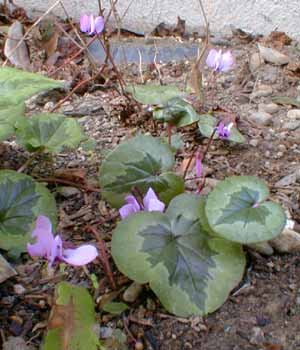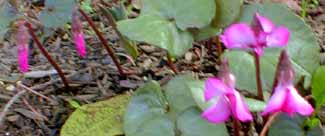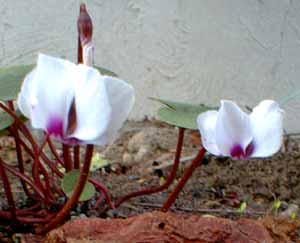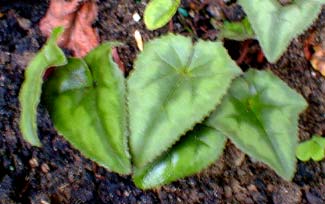 About Cyclamen Tubers
About Cyclamen Tubers
"Le soir verse les demi-teintes
Et favorise les hymens
Des veroniques, des jacinthes,
Des iris et des cyclamens."
-Renee Vivien,
1877-1909
We now obtain only seedlings of choice cultivars when we add new Cyclamens to our gardens, but a few years ago, before we knew any better, we obtained several large dried tubers of C. hederifolium, & C. persicum.
The mature tubers were about four inches round & one inch flat. Such tubers are unfortunately virtually always taken from the wild. I certainly will never purchase such things again, as even if I were too selfish to care about the wild ones, those which are nursery-grown have always done much better.
When nursery-grown from seeds, they will be healthier, with more variations to choose from. For examples, the cultivar shown in the first photo is C. coum 'Silver-leaf Pink' with green tree-silhouettes at the center of round frosty-edged leaves (shown late in February). The second photo shows C. coum 'Tilebarn Elizabeth' which has silvery-frosted leaves & two-tone flowers very unlike the wild form (shown in March). The specimen shown third on this page is C. coum 'Album' which has white flowers with a plum-colored "nose" (shown in February).
Among C. hederifolium cultivars available only as seed-grown stocks, we have 'White Cloud' with evenly pewtered leaves, & 'Green Elf' with scaled-down pint-sized leaves. The strongly hastate leaves of the 'Green Elf' are shown below at October's end, larger than life-size, the fourth photo on this page.
These & dozens of other varieties with variant leaves & various bloom colors are available from specialty growers. You will never see such variety if you buy the wild-gathered tubers instead of choice nursery-raised strains.
 If one goes ahead & obtains them as dried tubers, these will have been stripped from the wild, putting undue pressures on the environment. Plus they are frequently mislabeled so you think you bought C. coum but get instead C. persicum.
If one goes ahead & obtains them as dried tubers, these will have been stripped from the wild, putting undue pressures on the environment. Plus they are frequently mislabeled so you think you bought C. coum but get instead C. persicum.Although the dried tubers are cheaper than choice seedlings, the large tubers in fact do not often produce better, because in nature they do not like to be lifted, let alone have their roots shaved off before it is dried out for storage or shipment. They will usually remain weak or dormant for two years before springing back to life with any vigor. Many will simply rot in the ground rather than reinvigorate themselves at all, problems quickly avoided by starting with seedlings or with older specimens pot-grown from seeds. What survives will end up wonderful specimens in the very long run, but seedlings would've been doing well right from the start.
It may give one the illusion that buying the dried tubers gives one a "head start" on big leafy specimens, but that's almost never the case. By & large it is vastly better to start with nursery-grown specimens that have never undergone the terrible stress placed on tubers that have been root-shaved & dried out, & relying on actual growers means the gardener does not become a co-conspiritor in eradicating natural populations.
A substantially mature nursery-grown cyclamen will be several years old & sometimes pricy, but even comparatively inexpensive second-year C. coum & C. hederifolium seedlings will produce blooms the very first year they're in the garden. Those little seedlings are especially good to obtain for the purpose of planting up near the bases of the trunks of trees or shrubs, ideal locations for cyclamens, but places where you wouldn't want to have to dig a big hole for a tuber, for fear of injuring the tree roots. They develop rapidly & will in time self-seed to colonize the area.
 But I didn't always realize it was environmentally wicked & wrong to obtain dried tubers. Having obtained some of these tubers, I of course wanted to take the best possible care of them.
But I didn't always realize it was environmentally wicked & wrong to obtain dried tubers. Having obtained some of these tubers, I of course wanted to take the best possible care of them.When I first opened the package the C. hederifolium arrived in, I discovered one of three tubers was shrivelled & seemingly dead. I should've returned it to the seller but it wasn't worth the bother. The other two tubers were fleshy-smooth & healthy. I planted the unhealthy-looking one anyway in case it reconstituted itself, but of course it never did, so of three planted, only two patches of C. hederifolium under the choke cherry survived, not far from a patch of another cyclamen, & three autumns later, they still had never bloomed, though they produced nice patches of leaves & would eventually bloom. Come October of their third year or fourth autumn in the garden they began blooming splendidly, but it was a long wait during which time all the specimens obtained as nursery-grown were every so flowery every autumn.
Note, also, that I had actually ordered C. coum tubers when what grew were C. hederifolium, the bulb importers obtaining them from careless sources & packaging them for sale with further carelessness.
Though I've seen these large tubers called "corms" & "bulbs," they're actually neither, & for accuracy they should be called tubers. They are disc-shaped, concave on top. The bottom of the tubers are smooth; at the center of the concave top, each tuber shows small signs of where it produces stems. It would be easy to mistake these signs of stems for roots & so plant the tuber upside down.
 I planted the tubers a scant two inches deep with a tiny bit of bulb food underneath, & a considerable amount of leafmatter/compost over them. In colder climates they would be planted deeper.
I planted the tubers a scant two inches deep with a tiny bit of bulb food underneath, & a considerable amount of leafmatter/compost over them. In colder climates they would be planted deeper.A resident mole (whom I referred to as Mrs. Molesworth & whom I tolerated because she does little to no harm) took a disliking to that one tuber I'd planted even though I knew it had to be dead. The mole shoved it to the surface where I could see it had indeed rotted, so I finally tossed it. Possibly the protective toxins in cyclamen tubers are particulary noxious when such a tuber is decaying, inducing the mole to clear it out of the ground.
It cannot be that she only accidentally shoved it to the surface while cleaning grubs out of the rotting tuber, for she also ejected tulip bulbs from another area, but was not bothered by the narcissus & crocus bulbs which she never shoved up out of the ground. One other year we had a different mole take a disliking to jack-in-the-pulpits & ejected quite large ones to the surface; I had to admit I was glad when the cat got that annoying mole, though usually I find our smallish Olympic moles tolerable, & I do not molest them; they are territorial so there is only ever one present at any given time, they are good for aerating the soil, they eat harmful grubs, & in gardens where they do become more burdensome this is actually a sign of grub outbreak & the mole is actually doing good work to root around after as many grubs as can be found.
It's rare moles bother bulbs, because they are insectivores & are after the grubs & worms & slugs & sundry insects. When nosing around bulbs & tubers it's because there are harmful grubs to be eaten. Mrs. Molesworth never bothered the healthy cyclamen tubers, which were producing a few unimpressive leaves by late winter after their autumn planting.
There were also three C. persicum tubers. These are the only cyclamens which like to be planted with the top smooth surface of the bulb exposed to the air, though for Puget Sound winters it may be best to have them just barely under the soil since they're not nearly so cold-hardy as C. coum. Though C. persicum is not as garden-hardy as C. coum or C. hederifolium, the natural wild form in fact adapts well to a temperate zone, & it is only the fancier "florist cyclamens" that cannot live outside in our zone.
The first year I thought all three of the C. persicum tubers were dead; they did nothing. The second & third years, one of them produced leaves & beautiful flowers. The third year a second tuber produced leaves but no flowers. The third tuber never made any showing at all & probably rotted the first year. The two survivors are now excellent plants that bloom well for September/October.
That was a total of six tubers of which only four survived of which only one was flowering well before the third years. By contrast, I've never had a nursery-grown seedling die on me, & always had them flower the following autumn or winter after planting them.
Because Northwest winters are so moderate the tubers were safely started right out in the garden. But it is sometimes recommendable to get them started in moist peaty flat trays to resuscitate them & baby them back to life, as the root-shaving & drying they undergo before market does make them vastly more delicate than is otherwise the case with their normally hardy nature. When tray-resuscitated tubers are definitely beginning to grow, it's easier to be certain which side is up & not too late to flip them over if they were accidentally planted face-down in the trays. Once they've shown some vitality, that's when they can go right into the garden.
But of course the very best thing is to buy potted seedlings or slightly older potted cultivars from specialty growers, since whether for the selfish reason of wanting the best, healthiest, & most interesting plant, or from the environmentally aware reason of not wanting to contribute to the decimation of wild populations, there's just no reason to purchase packaged tubers.
Continue to
Cyclamen hederifolium,
basic Pink-flowering Pattern-leaf